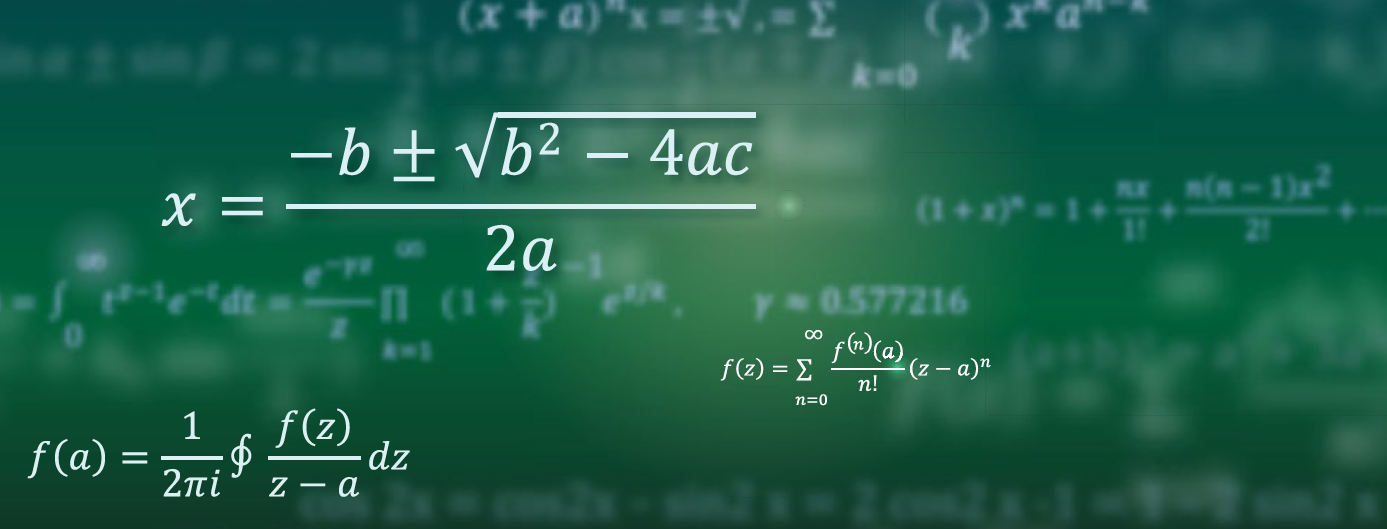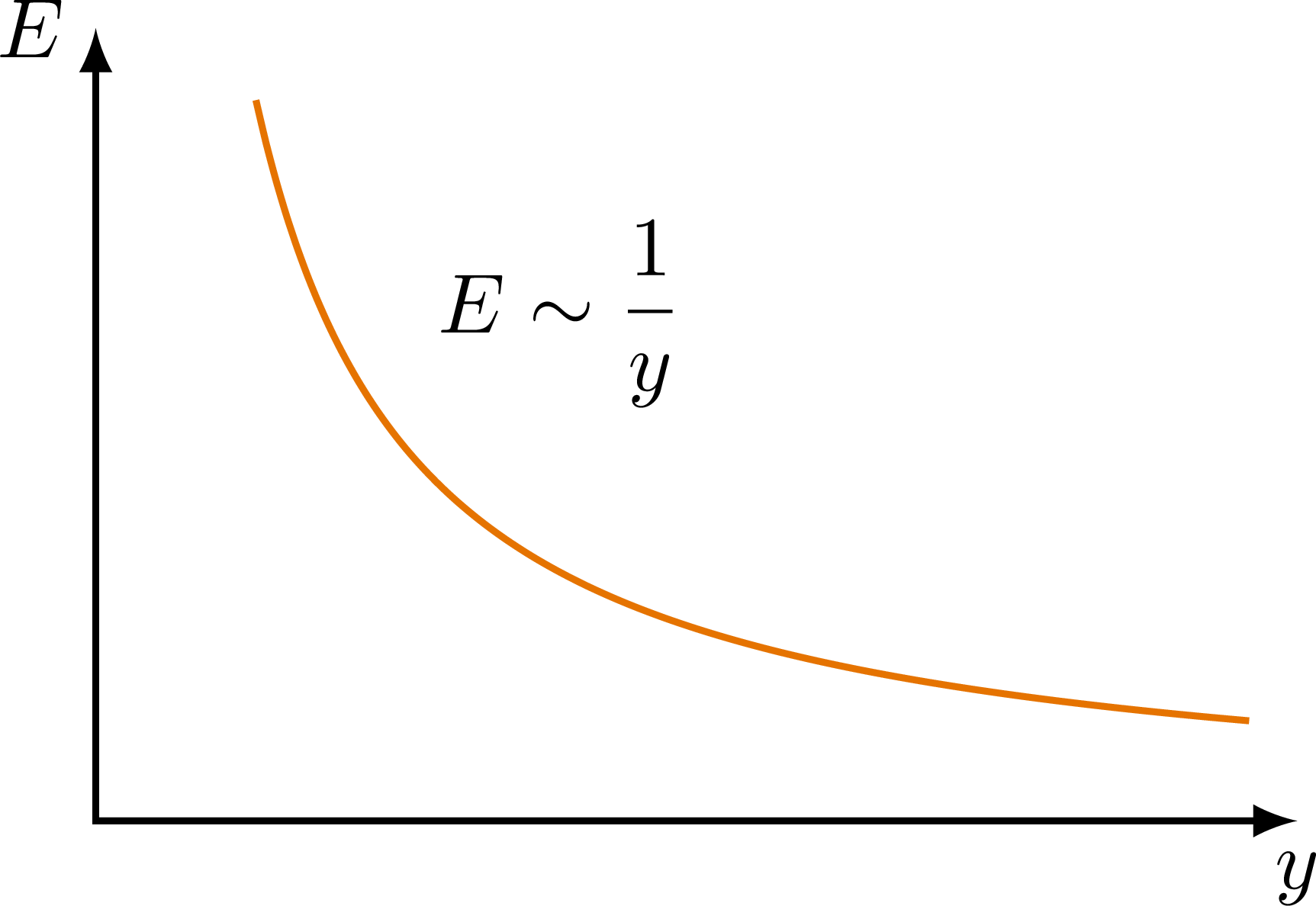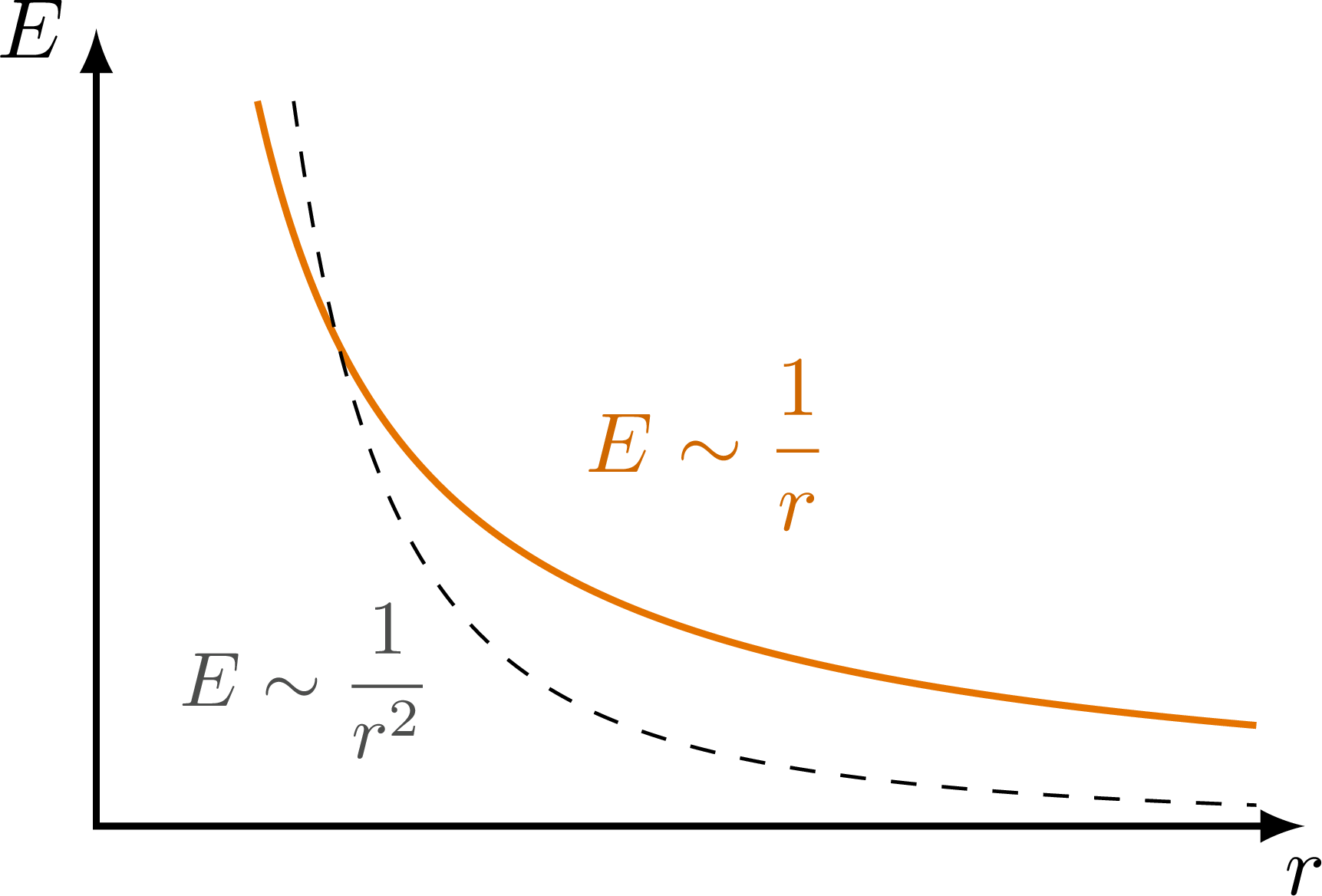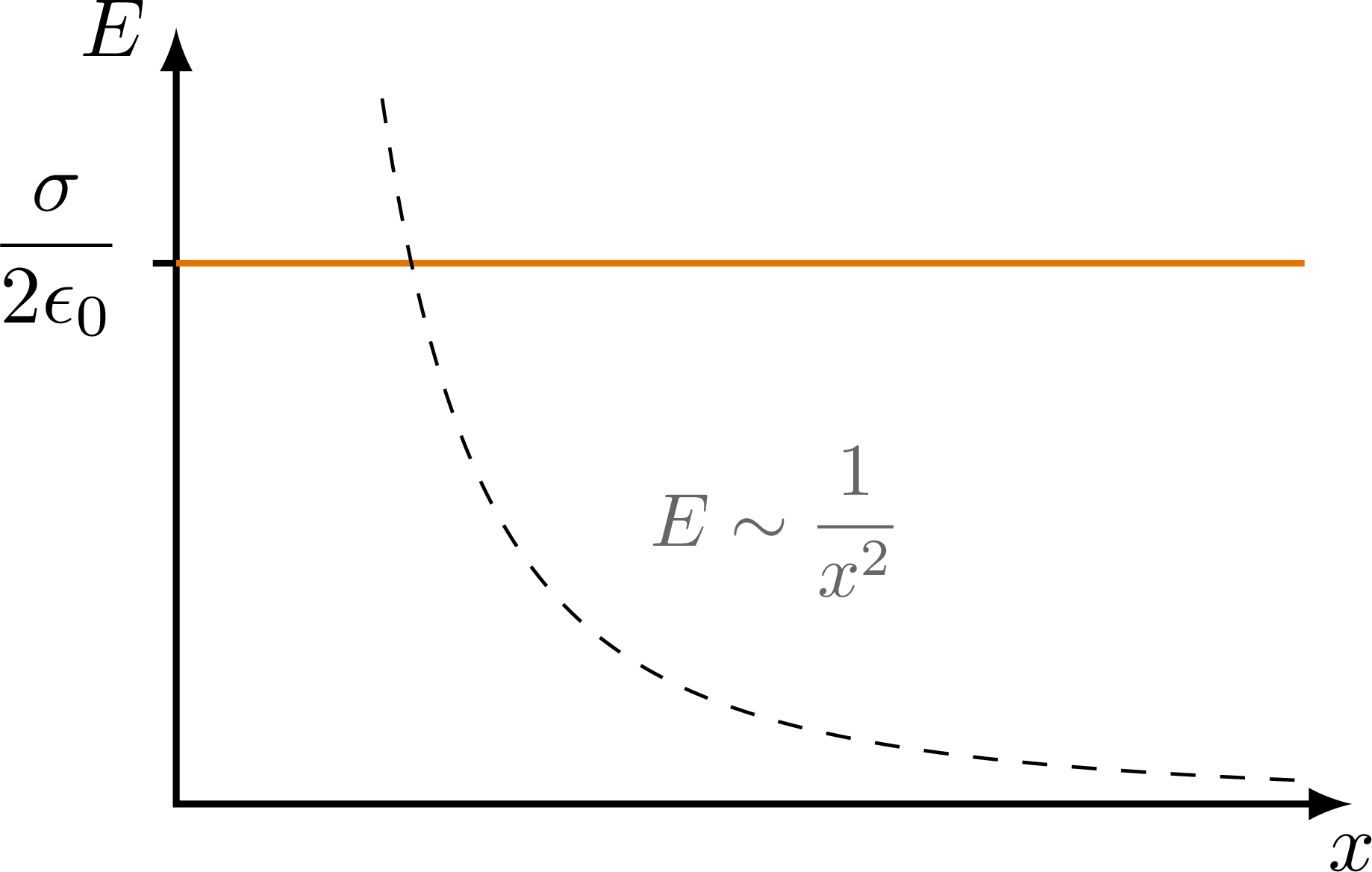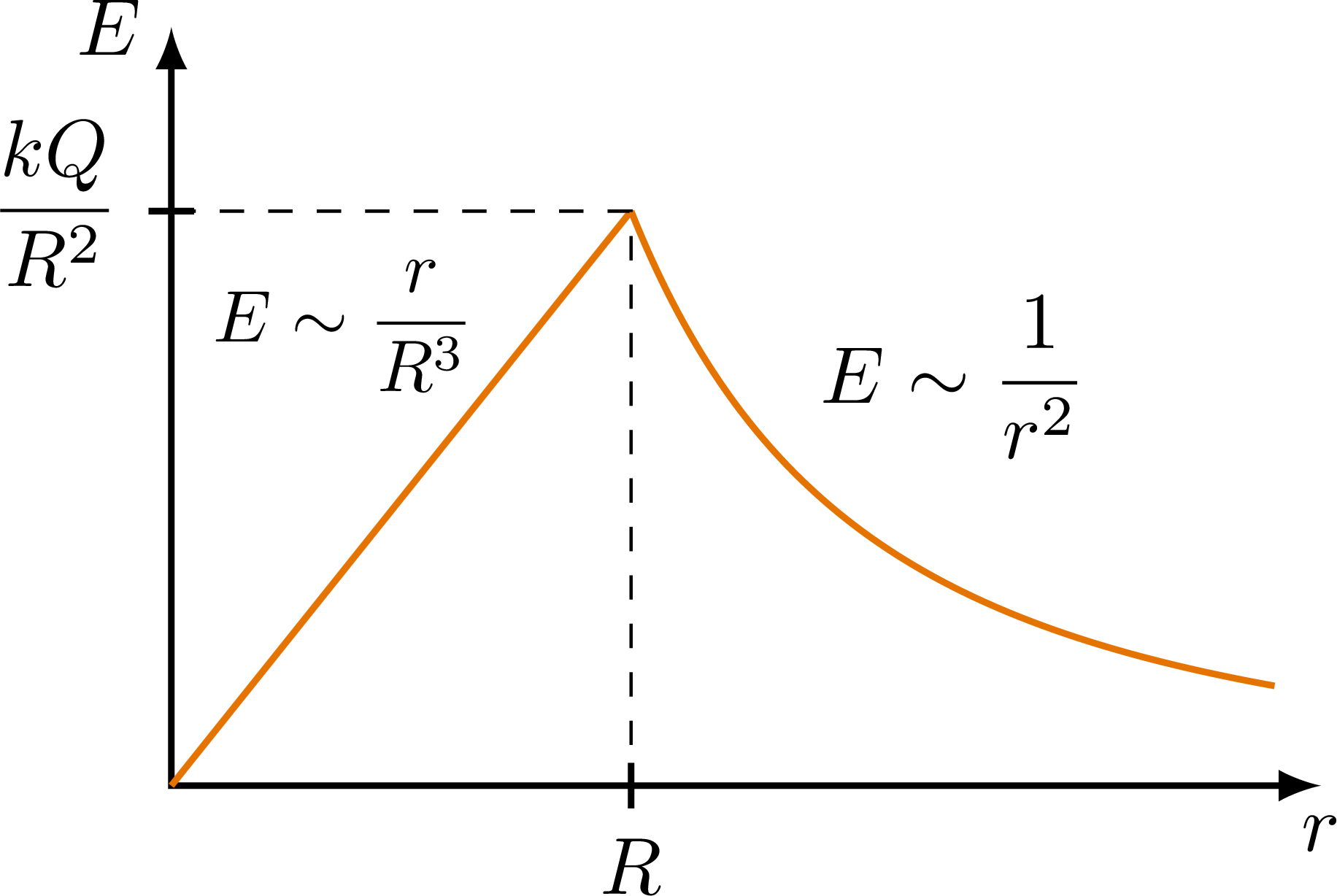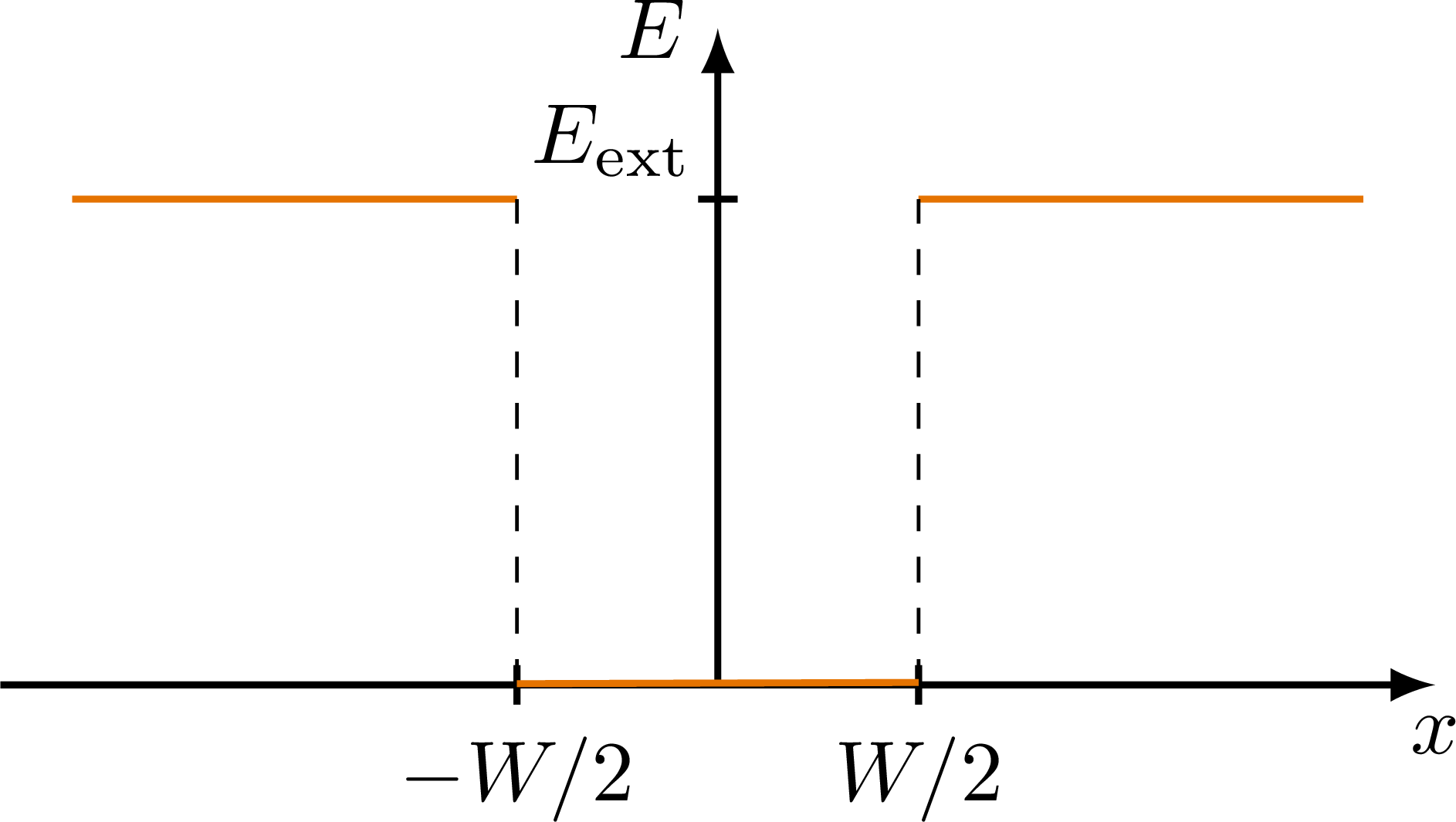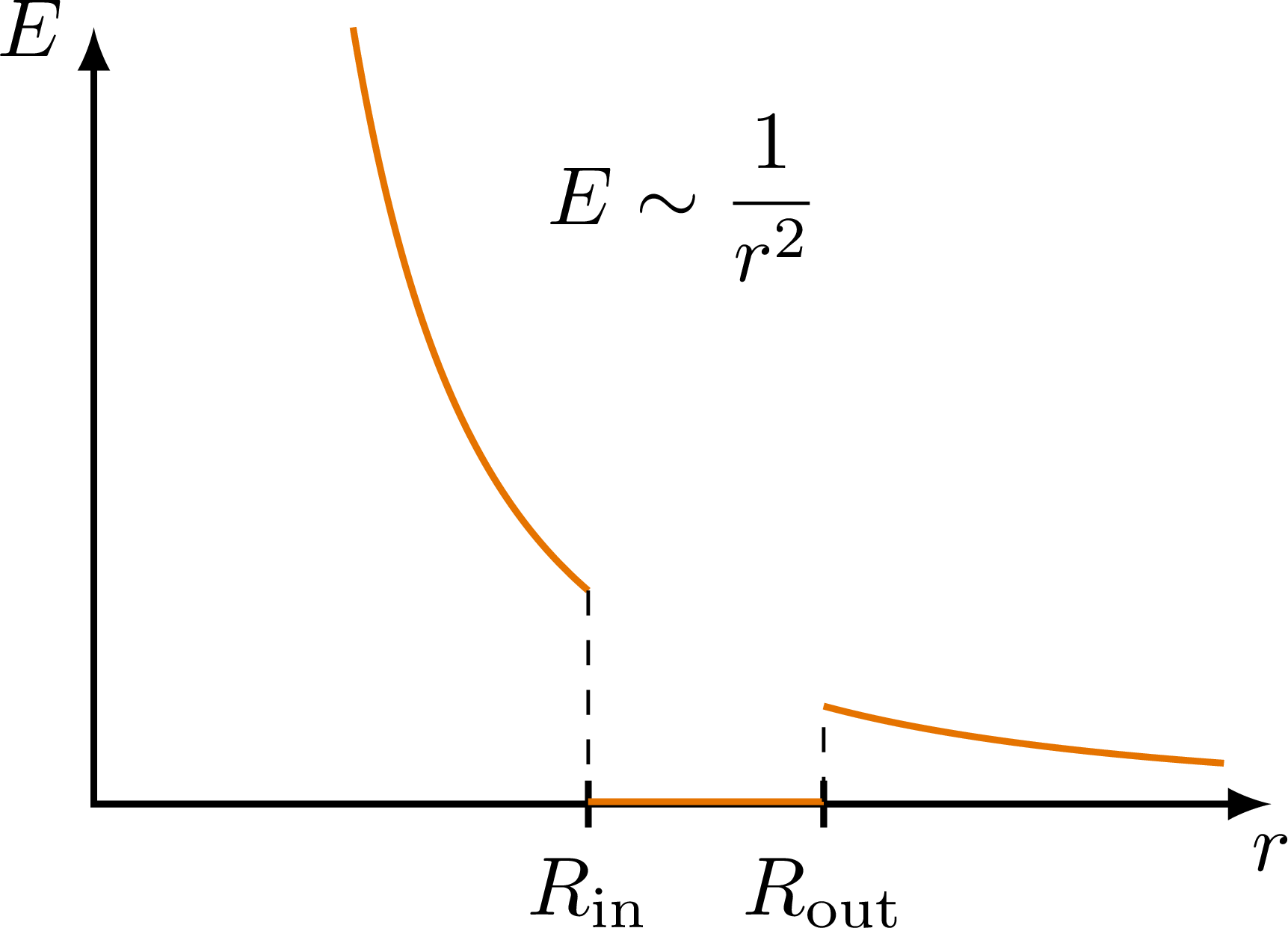Electric field strength of a charged rod, plane, solid sphere, hollow sphere or conducting sphere, as a function of radius r or distance x.
Edit and compile if you like:
% Author: Izaak Neutelings (Februari, 2020)
% page 8 https://archive.org/details/StaticAndDynamicElectricity
% https://tex.stackexchange.com/questions/56353/extract-x-y-coordinate-of-an-arbitrary-point-on-curve-in-tikz
% https://tex.stackexchange.com/questions/412899/tikz-calculate-and-store-the-euclidian-distance-between-two-coordinates
\documentclass[border=3pt,tikz]{standalone}
\usepackage{amsmath} % for \dfrac
\usepackage{physics}
\usepackage{tikz,pgfplots}
\usetikzlibrary{angles,quotes} % for pic (angle labels)
\usetikzlibrary{decorations.markings}
\tikzset{>=latex} % for LaTeX arrow head
\usepackage{xcolor}
\colorlet{Ecol}{orange!90!black}
\colorlet{veccol}{green!45!black}
\tikzstyle{EField}=[thick,Ecol]
\def\xmax{5.0}
\def\ymax{3.3}
\def\tick#1#2{\draw[thick] (#1) ++ (#2:0.03*\ymax) --++ (#2-180:0.06*\ymax)}
\begin{document}
% ELECTRIC FIELD of a ROD
\begin{tikzpicture}
\def\kQ{2.0}
\coordinate (O) at (0,0);
\coordinate (X) at (\xmax,0);
\coordinate (Y) at (0,\ymax);
% AXIS
\draw[<->,thick]
(X) node[below] {$y$} -- (O) -- (Y) node[left] {$E$};
% PLOT
\draw[EField,samples=100,smooth,variable=\x,domain={1.1*\kQ/\ymax}:0.96*\xmax]
plot(\x,\kQ/\x);
\node[above right] at (1.3,1.6) {$E \sim \dfrac{1}{y}$};
\end{tikzpicture}
% ELECTRIC FIELD of a ROD
\begin{tikzpicture}
\def\kQ{2.0}
\coordinate (O) at (0,0);
\coordinate (X) at (\xmax,0);
\coordinate (Y) at (0,\ymax);
% AXIS
\draw[<->,thick]
(X) node[below] {$r$} -- (O) -- (Y) node[left] {$E$};
% PLOT
\draw[EField,samples=100,smooth,variable=\x,domain={1.1*\kQ/\ymax}:0.96*\xmax]
plot(\x,\kQ/\x);
\draw[black!70,thin,dashed,black,samples=100,smooth,variable=\x,domain={sqrt(1.1*\kQ/\ymax)}:0.96*\xmax]
plot(\x,\kQ/\x^2);
\node[black!70,left,scale=0.9] at (1.5,0.6) {$E \sim \dfrac{1}{r^2}$}; %(0.9,2.9)
\node[Ecol!90!black,above right] at (1.9,1.1) {$E \sim \dfrac{1}{r}$};
\end{tikzpicture}
% ELECTRIC FIELD of a PLANE
\begin{tikzpicture}
\def\kQ{2.3}
\coordinate (O) at (0,0);
\coordinate (X) at (\xmax,0);
\coordinate (Y) at (0,\ymax);
% AXIS
\draw[<->,thick]
(X) node[below] {$x$} -- (O) -- (Y) node[left] {$E$};
\tick{0,\kQ}{ 0} node[below=-1,left] {$\dfrac{\sigma}{2\epsilon_0}$};
% PLOT
\draw[EField,samples=100,smooth,variable=\x,domain=0:0.96*\xmax]
plot(\x,\kQ);
\draw[black!60,thin,dashed,black,samples=100,smooth,variable=\x,domain={sqrt(1.1*\kQ/\ymax)}:0.96*\xmax]
plot(\x,\kQ/\x^2);
\node[black!60,left,scale=0.9] at (3.2,1.2) {$E \sim \dfrac{1}{x^2}$};
\end{tikzpicture}
% ELECTRIC FIELD of a CHARGED, SOLID SPHERE
% or ELECTRIC FIELD of a CONDUCTING SPHERE with excess charge
\begin{tikzpicture}
\def\kQ{10}
\def\R{2.0}
\coordinate (O) at (0,0);
\coordinate (X) at (\xmax,0);
\coordinate (Y) at (0,\ymax);
\coordinate (P) at (\R,\kQ/\R^2);
\coordinate (Px) at (\R,0);
\coordinate (Py) at (0,\kQ/\R^2);
% AXIS
\draw[<->,thick]
(X) node[below] {$r$} -- (O) -- (Y) node[left] {$E$};
\tick{Py}{ 0} node[below=-1,left] {$\dfrac{kQ}{R^2}$};
\tick{Px}{90} node[below] {$R$};
% PLOT
\draw[EField,samples=100,smooth,variable=\x,domain=0:\R]
plot(\x,\kQ*\x/\R^3);
\draw[EField,samples=100,smooth,variable=\x,domain=\R:0.96*\xmax]
plot(\x,\kQ/\x^2);
\node[scale=0.9] at (0.75,2.0) {$E \sim \dfrac{r}{R^3}$};
\node[above right] at (2.7,1.3) {$E \sim \dfrac{1}{r^2}$};
\draw[dashed]
(Py) -- (P) -- (Px);
\end{tikzpicture}
% ELECTRIC FIELD of a CHARGED SPHERE
\begin{tikzpicture}
\def\kQ{10}
\def\R{2.0}
\coordinate (O) at (0,0);
\coordinate (X) at (\xmax,0);
\coordinate (Y) at (0,\ymax);
\coordinate (P) at (\R,\kQ/\R^2);
\coordinate (Px) at (\R,0);
\coordinate (Py) at (0,\kQ/\R^2);
% AXIS
\draw[<->,thick]
(X) node[below] {$r$} -- (O) -- (Y) node[left] {$E$};
\tick{Py}{ 0} node[below=-1,left] {$\dfrac{kQ}{R^2}$};
\tick{Px}{90} node[below] {$R$};
% PLOT
\draw[EField,samples=100,smooth,variable=\x,domain=\R:0.96*\xmax]
plot(\x,\kQ/\x^2);
\draw[EField]
(0,0.004*\ymax) --++ (Px);
\node[above right] at (2.7,1.3) {$E \sim \dfrac{1}{r^2}$};
\draw[dashed]
(Py) -- (P) -- (Px);
\end{tikzpicture}
% ELECTRIC FIELD of a CONDUCTING SLAB
\begin{tikzpicture}
\def\xmax{5.9}
\def\ymax{2.7}
\def\E{0.74*\ymax}
\def\W{0.28*\xmax}
\coordinate (O) at (0,0);
\coordinate (XL) at (-\xmax/2,0);
\coordinate (XR) at (\xmax/2,0);
\coordinate (Y) at (0,\ymax);
% AXIS
\draw[->,thick]
(XL) -- (XR) node[below] {$x$};
\draw[->,thick]
(O) -- (Y) node[left] {$E$};
\tick{-\W/2,0}{90} node[below] {$-W/2$};
\tick{\W/2,0}{90} node[below] {$W/2$};
\tick{0,\E}{0} node[above=2,above left=-3] {$E_\text{ext}$};
% PLOT
\draw[EField]
(-0.45*\xmax,\E) -- (-\W/2,\E);
\draw[EField]
(\W/2,\E) -- (0.45*\xmax,\E);
\draw[dashed]
(-\W/2,0) -- (-\W/2,\E);
\draw[dashed]
( \W/2,0) -- ( \W/2,\E);
\draw[EField]
(-\W/2,0.005) -- (\W/2,0.01);
\end{tikzpicture}
% ELECTRIC FIELD of a CONDUCTING SPHERE with a cavity
\begin{tikzpicture}
\def\kQ{4}
\def\Rin{2.1}
\def\Rout{3.1}
\coordinate (O) at (0,0);
\coordinate (X) at (\xmax,0);
\coordinate (Y) at (0,\ymax);
% AXIS
\draw[<->,thick]
(X) node[below] {$r$} -- (O) -- (Y) node[left] {$E$};
\tick{\Rin,0}{90} node[below] {$R_\text{in}$};
\tick{\Rout,0}{90} node[below] {$R_\text{out}$};
% PLOT
\draw[EField,samples=100,smooth,variable=\x,domain={sqrt(1.0*\kQ/\ymax)}:\Rin]
plot (\x,\kQ/\x^2);
\draw[dashed]
(\Rin,\kQ/\Rin^2) -- (\Rin,0.01);
\draw[EField]
(\Rin,0.01) -- (\Rout,0.01);
\draw[dashed]
(\Rout,0.01) -- (\Rout,\kQ/\Rout^2);
\draw[EField,samples=100,smooth,variable=\x,domain=\Rout:0.96*\xmax]
plot (\x,\kQ/\x^2);
\node[above right] at (1.8,2.1) {$E \sim \dfrac{1}{r^2}$};
\end{tikzpicture}
\end{document}
Click to download: electric_field_plots.tex • electric_field_plots.pdf
Open in Overleaf: electric_field_plots.tex

